

110307 Differential Equations
From 110302:
`q005. Repeat the preceding exercise (the equation is y '' + 3 y ' - 4 y = t ln(t)), but this time assume that y_1 u_1 ' + y_2 u_2 ' = 0. This will greatly simplify the expression for y ', which was u_1 ' y_1 + u_1 y_1 ' + u_2 ' y_2 + u_2 y_2 '. In turn, this will simplify the expression for y ''.
With the above modification, what do you get when you substitute into the equation?
****
#$&*
`q006. In the above, the constants you when you take the derivatives of e^t and e^(-4 t) actually confuse the issue.
Just let y = u_1 y_1 + u_2 y_2.
You get
y ' = u_1 ' y_1 + u_1 y_1 ' + u_2 ' y_2 + u_2 y_2 '
but with u_1 ' y_1 + u^2 ' y_2 = 0 this is just
y ' = u_1 y_1 ' + u^2 y^2 ' ,
so
y_2 '' = u_1 ' y_1 ' + u_1 y_1 '' + u_2' y_2 ' + u_2 y_2 ''.
Plug these expressions into the equation and see what you get.
****
#$&*Collect all the terms which are multiples of u_1, and write them with u_1 factored out.
Collect all the terms which are multiples of u_2, and write them with u_2 factored out.
Two terms will remain.
What is your equation, in this form?
****
#$&*
The u_1 and u_2 terms should be
(y_1 '' + 3 y_1 ' - 4 y_1) u_1
and
(y_2 '' + 3 y_2 ' - 4 y_2) u_2
Since y_1 and y_2 are solutions of the equation y '' + 3 y ' - 4 y = 0, these terms will be zero.
What is left of your equation after you remove these terms?
****
#$&*
This equation, along with the equation y_1 u_1 ' + y_2 u_2 ' = 0 (assumed earlier), give us two simultaneous equations in the unknowns u_1 and u_2. What are those equations?
****
#$&*
Write these equations as matrix equations. Do you recognize the matrix on the left-hand side?
****
#$&*
What is the determinant of that matrix?
****
#$&*
For 110307:
`q001. Find the solution of the equation
y ' ' + y ' + 4 y = sin(omega * t)
and interpret as the equation of motion of a damped pendulum, and also as the equation of an RLC circuit.

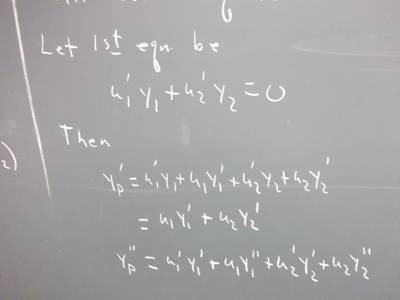

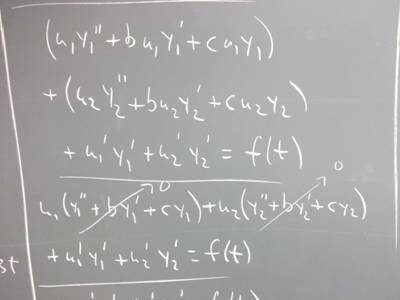

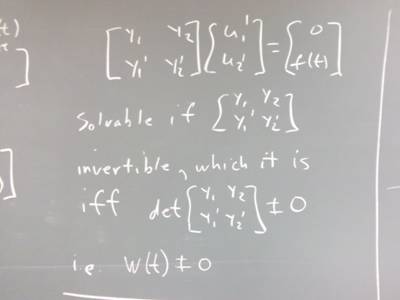

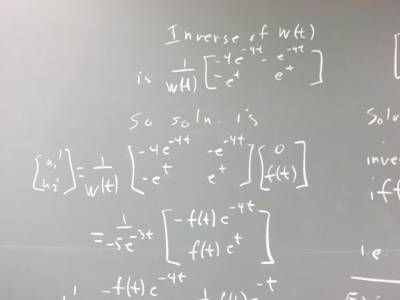
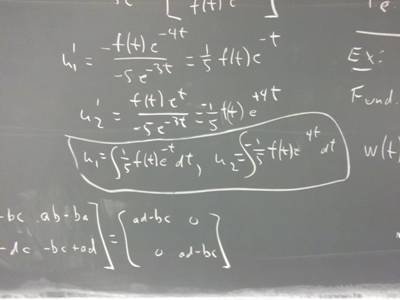
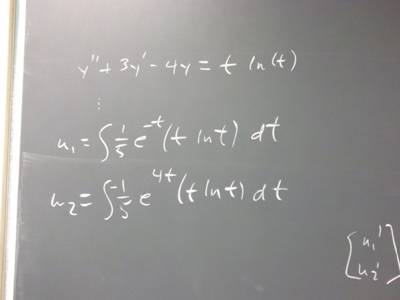
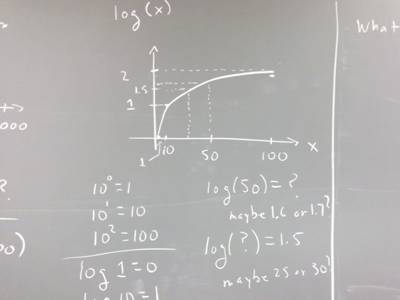
Notes below document a contradiction in the solution of a problem.
First, for comparison, we solve the logistic equation:


The solution is P = N / (1 + C e^(-N k t) ), with C = ( N - P_0 ) / P-0.
Now we solve, replacing k with 2 e^-t - 1. This represents an intervention that has little effect at first, but which eventually becomes negative and drives the population down, ultimately leading to extinction of that population.
(in the third step the left-hand side wasn't written down, but will be ln | P / (N - P) | . The factor 1 / N from the integration has already multiplied out, accounting for the N on the right-hand side.)
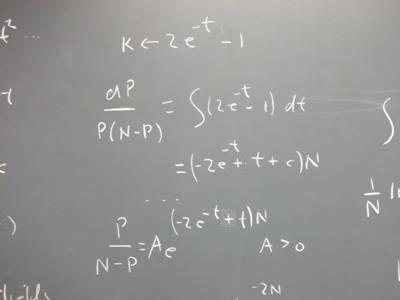
For any significant population, e(- 2 N) yields a very small value, implying a very large A.

... but that's going to balance out, sort of ...













